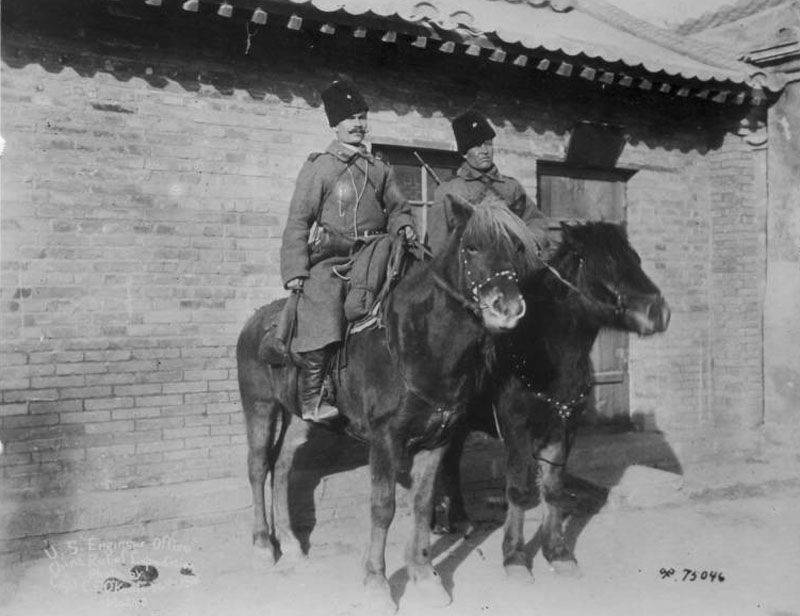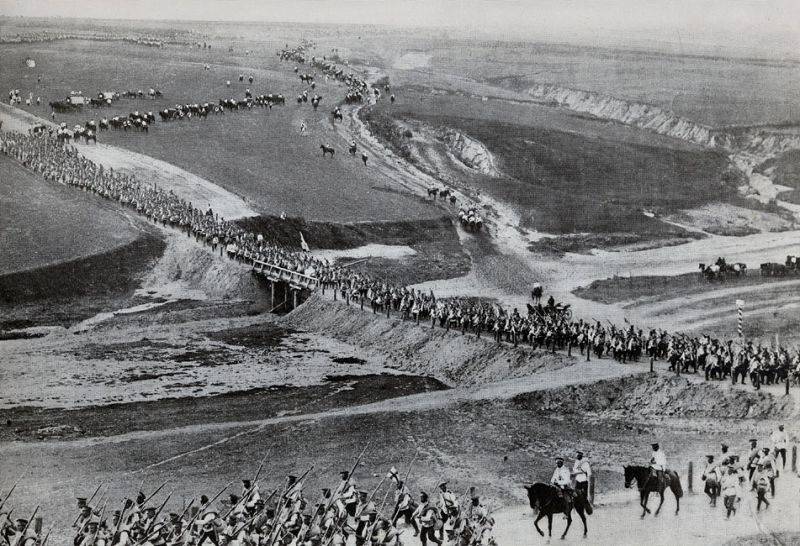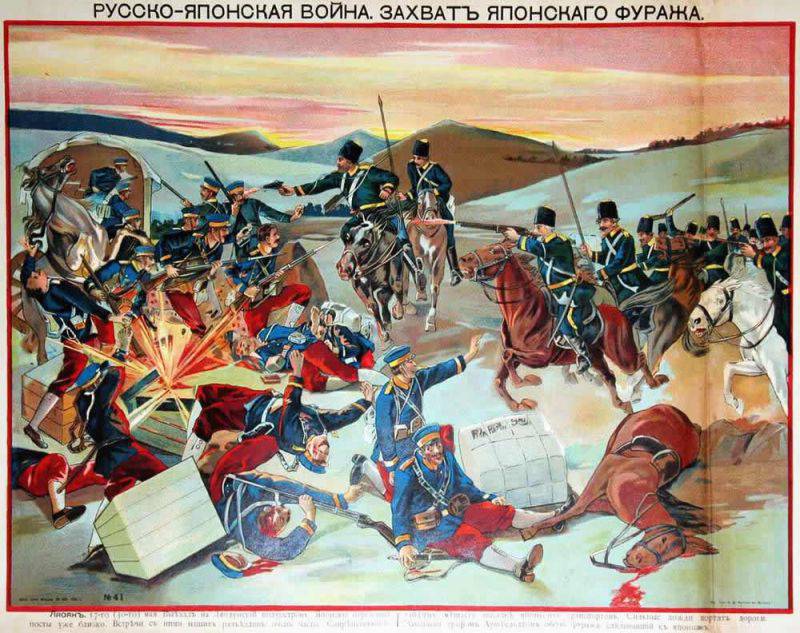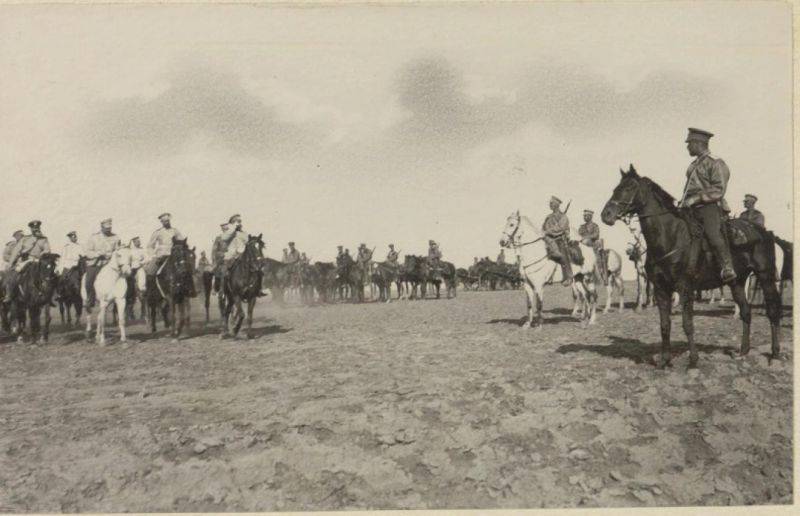Cossack raid Mishchenko in the Japanese rear in the Russian-Japanese war
Based on the situation, the command of the Russian troops in Manchuria decided to recall the experience of 1812 of the year, as well as the successful Cossack raids in the Russian-Turkish wars. It was decided to organize a similar operation, which included a deep raid on the Japanese rear. For this purpose, a large combined detachment of cavalry was formed under the command of Adjutant General Pavel Ivanovich Mishchenko. The detachment included units of the Caucasian Cossack Brigade, the Ural-Trans-Baikal Cossack Division, the 4 of the Don Cossack Division, units of dragoons, sappers and border guards. The squad included fairly large forces: 71 squadron and Cossack hundreds, 4 horse-hunting teams (reconnaissance), as well as 22 guns and 4 machine guns. Total detachment consisted of about 7 thousands of people. In addition, a pack of transport was included in the squad (more 1500 packs), and each of the riders had to take with them a supply of food, covering a two-week need.
The task of this consolidated detachment was a raid on the territory occupied by the Japanese. The raid was to end with the capture of the port of Yingkou, located on the shores of Liaodong Bay. From this port, the Japanese troops were supplied with cargo and food. It was also necessary to disable the railway bridges, the station and the railroad bed in order to prevent the transfer of new Japanese troops to the front. Everything that happened in the future is easily described by the well-known Russian saying “swing on the ruble, kick a penny.”
Conditions for the raid on the enemy rear were favorable. The Japanese had weak and small cavalry. Infantry, which was engaged in the protection of communications, was scattered in the fortified points, located away from the route of the detachment. The raid area was an open plain, fertile and not exhausted by war, it could provide soldiers and horses with supplies. And the time was favorable, because in the winter months in Manchuria the roads were passable everywhere - the swamps and rivers froze. The weather was normal. With complete calm, the air temperature was 1-2 degrees of frost during the day, at night the temperature dropped to -8 degrees.
27 December 1904, an equestrian squad set out on a march. It immediately became clear that the pack transport strongly delays the detachment, reducing its speed. The squad moved on foot. On their way to follow them, a certain number of enemy patrols and carts were destroyed, small batches of Japanese and Hunghuz were detained. In these small skirmishes, partisans and advanced parts of the detachment's detachments took part, to which larger units, sometimes whole Cossack regiments, gradually began to join. It happened against the background of repeated orders of the head of the detachment, General Mishchenko, about a bypass of Japanese forces that were in passing villages. These clashes not only delayed the already slow progress of the consolidated detachment, but also burdened him with the appearance of the wounded.
December 29 3 batch (consisting of 5 hundreds and 1 squadron) with disruptive means were separated from the joint squad. They were supposed to disable two bridges at Heichen and one at Dashichao. All three parties were able to reach the railway, but failed to get close to the bridges and blew up only the rails and telegraph poles. After that, Mishchenko finally chose Yingkou as his main goal. He decided to come out for the defeat of this station in such a way as to approach it already at dusk and under the cover of darkness on the ground to attack the enemy, destroy station buildings and burn the warehouses. For the Yingkou assault, hundreds of 15 (one from each regiment) were appointed, as well as 4 equestrian hunting teams with disruptive assets. They were commanded by Colonel Khoranov. The forces were frankly weak, considering that there were about 7 thousands of horsemen in the detachment, not counting artillery, reconnaissance and auxiliary units. For whatever reason, Mishchenko allocated such limited funds from the available forces, contemporaries can only guess.
The main forces of his detachment approached Yingkou on 3-4 versts, then artillery fire was first opened first on a train coming from Dashichao, which delivered another battalion of Japanese infantry to Yingkou (in total Yingkou defended two battalions), and then the station itself. At around midnight 6, when it was already dark, the artillery set fire to the Japanese warehouses, after which it ceased firing. Part of the detachment went to the railway and began to spoil it. At this time, the assault squad dismounted, and at about 7 hours of the evening moved to the station, which was lit by the glow of the fires. As soon as the attackers were in a lighted zone lit by fires, the Japanese infantry fired volley fire at them. Several hot but not amicable attacks of dismounted equestrian, which were also carried out in the forehead of the Japanese defense, led nowhere. The Japanese infantry, strengthened in stone buildings and trenches, was able to repel all attacks at the station, and the Russian detachment lost more than 200 people, the rest, turning into porters for a time (carrying out the dead and wounded), retreated.
Upon learning of the unsuccessful assault, General Mishchenko, at about 9 hours of the evening, ordered to retreat. The return march of the detachment was not the easiest. The crossing of the columns through the Liao He met significant difficulties, since the ice was thin, and polynyas formed near the banks. For this reason, the crossing was completed only by 3 hours of the night. They came out in three columns. The column closest to the Japanese was General Teleshov’s Donets, in the middle of the detachment there was a column of General Abramov, in the western column there were dragoons led by General Samsonov. The wounded were in the middle column. General Teleshov's left column, at dawn on 1, January 1905, withstood the Japanese units, detaining the enemy until the main forces approached. In the future, the enemy several times tried to intercept the cavalry unit, but all these attempts were fairly easily repulsed by the Don. By the evening of January 2, the combined cavalry unit Mishchenko, who was no longer disturbed by the enemy, was able to connect with the detachment of General Kossagovsky, who was sent to meet him. After another 3 of the day, Mishchenko’s squad was completely disbanded.
So in general terms about this campaign is described in Russian historiography. In total, from 27 December 1904 of the year to 3 of January 1905, the detachment overcame 250 versts, that is, 31 versts per day (for cavalry, not the most outstanding figure). During the raid, squad casualties amounted to 40 officers and 361 lower ranks. During this time, they scattered and captured several Japanese rear teams. Several small warehouses were burnt down, an arb (a high two-wheeled vehicle) with supplies was destroyed, 600 people were taken prisoner. At the same time, the detachment forces failed to take and destroy Yingkou, to destroy the railway bridges and any capital facilities of the enemy. The main objectives of the raid were not achieved.

The raid of the Mishchenko detachment was an example of the unsuccessful implementation of a design that was not the most useless in the situation. It was not the fault of the Cossacks and dragoons that this raid ended not as planned. Deprived of sufficient mobility, horse units with packs and artillery attached could not carry out the operation quickly and swiftly, as their fathers and grandfathers did. The short-sightedness and miscalculations of the command were characteristic of the Russian-Japanese war, which became one of the most unfortunate for Russia and was the forerunner of the death of the Russian empire. But the raid Mishchenko himself was not forgotten, thanks to folklore. It was at that time that the song appeared: “Behind the Liaohe River, the lights came on”, which already in 1924 was successfully remade in a new way, turning the song “There Far Away” into the more famous today, replacing the Cossacks and Manchuria with Red Army men and Ukrainian steppes.
The reasons for the failure raid Mishchenko
One of the reasons for the failures of the raid was the large number of detachment, which simply could not covertly act in the rear of the enemy. At that time, the command of the Russian army vaguely imagined the tactics of guerrilla operations. The command of the detachment did not care about any concealment of the maneuver either. The detachment many times entered into minor clashes with the Japanese, who distracted him from the main goal. To damage the railroad tracks several times, Mishchenko sent out separate detachments, which, however, could not be seriously put to the Japanese. Each time they were aware of the impending attack on a particular point, preparing it for defense in advance. A characteristic feature of the raid was that its preparation, information about which, according to unwritten partisan rules, was to be kept secret, was known not only to local Chinese, correspondents, but even to the French missionary. Preparations for the raid did not remain a secret for the Japanese command, which had a good agent network in the combat area. In 1905, Colonel Gillenschmidt, who with the 400 detachment man, kept his conspiracy, avoiding clashes with the enemy and contacts with the local population, successfully solved his task - eliminated all these flaws - destroyed the railway bridge on the Liaoyang - Hicheng - Tashichao line, passing the 5 day. 400 kilometers and not being previously detected by the enemy.
The presence of attached artillery in the detachment, 22 guns seriously restrained the advance of the units, which turned out to be completely superfluous. In addition, the soldiers were forced to carry fodder and food. At the same time, it was very inconvenient to move with the cargo, so some of the food and feed were thrown. Troops moved for the most part at random (there were simply no good cards), first in four and then in three columns. The distance between the columns was 2-4 kilometers. The connection between them was maintained by means of watch. At the same time, reconnaissance patrols were not efficient enough and could not prevent unwanted clashes with the Japanese on time.
Although Yingkou was one of the main targets of the raid, the detachment was not ready for battle. This is confirmed by the fact that in 11-12 kilometers from the target, the detachment stopped and, for some unknown reason, stood for 3-4 hours. The Japanese took advantage of this in order to prepare as best they could for the meeting. It was decided in advance to attack in the dark, but no one had conducted preliminary reconnaissance, so the command did not know that the Japanese had reinforced the station and erected artificial obstacles. The forces of the detachment were strangely distributed at the moment of the attack. In the direction of the main attack, barely a quarter of the available troops were involved, and Mishchenko himself did not participate in the operation. Artillery bombardment before the attack was largely unsystematic and did not bring the enemy serious damage. However, the fire that occurred at the station after the shelling, illuminated the terrain and helped the enemy to detect the attackers. The attackers tried to reach the Japanese positions not in the dark, but in the light of the fires of a burning warehouse. At the same time, the defenders were in buildings and trenches that were not lit by fire. In such conditions, the chances of success of frontal attacks were nil, but our commanders, alas, failed to offer anything else.
Someone associates the unsatisfactory causes of the raid with the untimely campaign and the wrong choice of target. The delay was due to the fact that the raid was carried out during a lull at the front, and not during intense fighting. For this reason, the Japanese were very easily able to restore all the damage caused by the detachment, while at the same time the moral significance of the next failure had a heavy effect on the Russian units. The fallacy of the strike goal is explained by the fact that instead of attacking a secondary port, it would be worthwhile to organize a major destruction of the railroad on the Liaoyan-Dashichao section, which was part of the communications line from the main Japanese base, Dalny and the main bridges and viaducts along the way. Such actions would indeed slow down the advancement of the Army Legs and ease the position of the Russian Manchurian army.
Information sources:
http://www.proza.ru/2012/10/05/827
http://геоамур.рф/sources/history/history_modern/history_modern-x=08$24.php
http://hist.ctl.cc.rsu.ru/Don_NC/XIXend-XX/Voiny_rus_jap.htm
http://zavtra.ru/content/view/udalyie-komsomoltsyi



Information